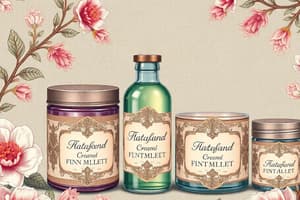Podcast
Questions and Answers
Which characteristic is crucial for a cream or ointment to be considered consumer acceptable?
Which characteristic is crucial for a cream or ointment to be considered consumer acceptable?
- Should support microbial growth
- Should not be easily removed
- Must be toxic and sensitizing
- Must be non-toxic, sensitizing, and well tolerated (correct)
What is a key requirement for a topical formulation to be considered aesthetically pleasing?
What is a key requirement for a topical formulation to be considered aesthetically pleasing?
- Should be difficult to apply
- Should not support microbial growth
- Must remain at the site of application (correct)
- Must have a strong medicinal odor
What is essential for a cream or ointment to achieve patent protection?
What is essential for a cream or ointment to achieve patent protection?
- Being highly toxic
- Supporting microbial growth
- Should not support microbial growth (correct)
- Being difficult to remove
What is a critical consideration in the formulation production of creams and ointments?
What is a critical consideration in the formulation production of creams and ointments?
Which feature is necessary for a topical formulation to be easily applied?
Which feature is necessary for a topical formulation to be easily applied?
What is a critical aspect of a gel formulation in terms of consumer acceptability?
What is a critical aspect of a gel formulation in terms of consumer acceptability?
In the context of drug release activities, what would hinder a cream's effectiveness?
In the context of drug release activities, what would hinder a cream's effectiveness?
Flashcards are hidden until you start studying
Study Notes
Creams and Ointments Formulation
- Drug release into/across the skin is a critical aspect of creams and ointments formulation.
- Stability of the active ingredient and preservative is affected by ICH conditions, making it challenging to maintain stability.
- Drug recovery can be complicated and hard to validate, with a tolerance of ±5% of label claim over shelf life.
- Related substances/degradation products exceeding 0.1% must be identified and limited.
Physical Properties
- Visual and microscopical appearance, feel, color, odor, and presence of particles are important factors to consider.
- pH levels (if applicable) can indicate potential future drug, preservative, and viscosity problems.
Viscosity and Microbial Contamination
- Viscosity affects extrusion from tubes, application to skin, and spreadability, and must be retained over the shelf-life.
- Microbial contamination in unopened containers and under conditions of use is a significant concern.
Topical Formulations
- Semi-solids include gels (aqueous and non-aqueous) and ointments (oleaginous and non-oleaginous).
- Creams and ointments are classified based on their composition, including hydrocarbon, absorption, and emulsifying ointment bases.
Ointment Bases
- Hydrocarbon ointment bases include mineral oils, combinations of paraffins and waxes, and are liquid to solid.
- Absorption ointment bases contain an emulsifying agent to soak up water or aqueous secretions, forming a water-in-oil system.
- Emulsifying ointment bases are similar to absorption bases but form a water-in-oil system, and are classified based on the ionic nature of the emulsifying agent.
Water-Soluble Ointments
- Water-soluble ointments contain mixtures of water-soluble high and low molecular weight PEGs, and range in properties from liquids to solids.
- They mix readily with skin secretions, spread easily, and can be washed from the skin.
New Generation Topical Formulations
- New generation topical formulations include sprays and foams.
Formulation Selection
- Formulation selection depends on factors such as location in the skin, lag time, delivery profile, consumer acceptability, and patent protection.
Formulation Production Issues
- Stability and compatibility of the drug must be ensured.
- The formulation must not support microbial growth, and must be non-toxic, non-sensitizing, and well-tolerated.
- The formulation must be easily applied, remain at the site of application, and be easily removed, while also being aesthetically pleasing.
Studying That Suits You
Use AI to generate personalized quizzes and flashcards to suit your learning preferences.



